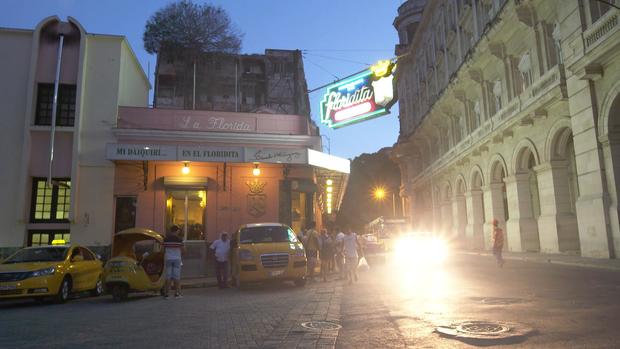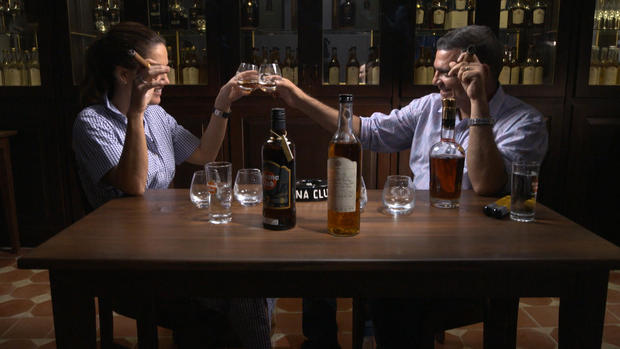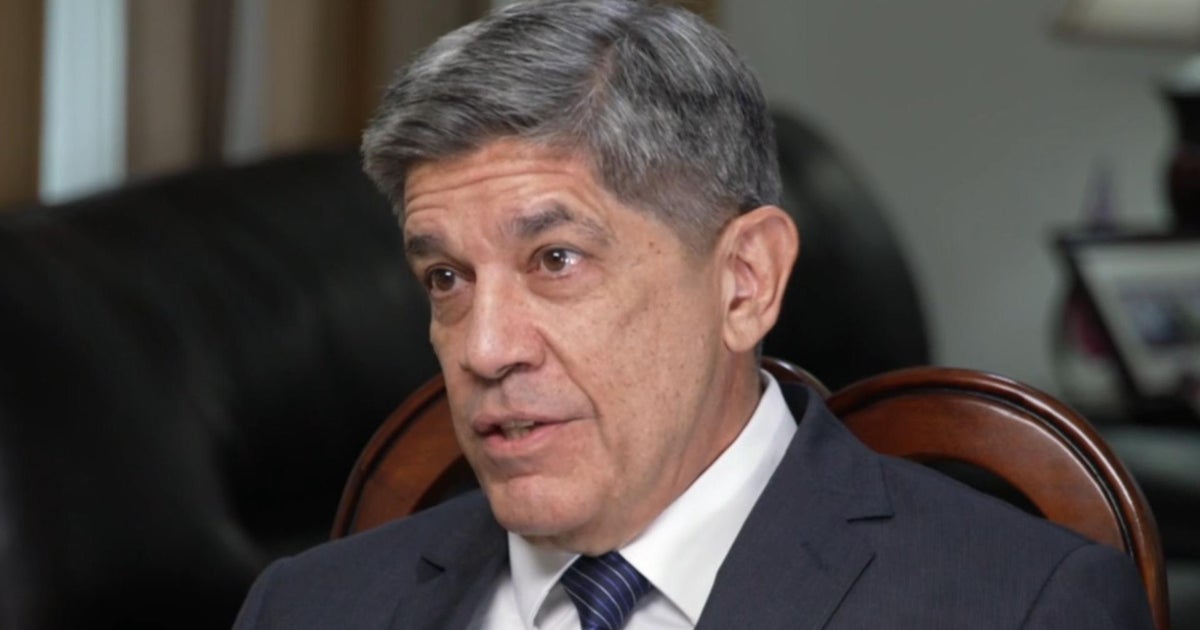The Rum War
The following script is from “The Rum War,” which aired on Jan. 1, 2017. Sharyn Alfonsi is the correspondent. Rome Hartman, producer.
The relationship between Cuba and the United States was stuck in pretty much the same bad place for half a century. But things have been changing at a dizzying pace in the last couple of years.
President Obama started the thaw in the relationship by re-establishing diplomatic relations and easing restrictions on travel. Now President-elect Trump is threatening to undo all those moves. And Fidel Castro, who spent 50 years poking his thumb in the eye of every American president, has died.
Whatever happens, there’s already a war underway that has the U.S. and Cuba on the rocks. It’s a war over rum, specifically, over two different versions of Havana Club rum and it’s as bitter as the Cold War ever was.
It’s a Tuesday afternoon at El Floridita in Old Havana, and we and lots of other visitors to Cuba are filing in and filling up at the bar that calls itself the “Cradle of the Daiquiri.” Head bartender Alejandro Bolívar needs to double up on rum bottles just to keep up with demand.
Sharyn Alfonsi: How many bottles do you go through a day? Any idea?
Alejandro Bolívar: So it’s at-- it’s between 60 and 80-- 80 bottles per day.
Sharyn Alfonsi: That’s a lotta daiquiris.
Alejandro Bolívar: Yeah. Plenty of empty bottles.
Sharyn Alfonsi: Oh my gosh. Is this just from today?
Alejandro Bolívar: Yeah. Today, yeah.
All those bottles were filled with Havana Club rum, produced by a 50-50 joint venture between the Cuban government and the French beverage giant Pernod Ricard, which sent Jérôme Cottin-Bizonne to Cuba to run the business. We met him in a place that’s rarely open to outsiders: a warehouse stacked to the ceiling with oak barrels full of rum.
Jérôme Cottin-Bizonne: We built a very great success with Havana Club. When we started the partnership in 1993 we sold five million bottles a year. Today, we sell 50 million bottles a year.
50 million bottles, 11 million of them sold here in Cuba. The tourists drinking Havana Club are obvious, but we went looking down the side streets, and found locals drinking it too…at domino games and dance halls and discos…and sipping it along Havana’s seafront promenade, the Malecón.
To distill and age all that rum, the Cuban government and Pernod Ricard rely on Asbel Morales, Havana Club’s master rum-maker. He loves talking about rum, but he says to really understand it, you have to drink it.
Sharyn Alfonsi: Es muy bueno.
Asbel Morales: Muy Bueno.
“The first sip will impact you the most,” he said, “and make you anxious for a second.”
Sharyn Alfonsi: I am anxious to continue the second sip.
And the third, and the fourth, and the Cohiba cigar that he says pairs perfectly with this Havana Club. As we drank and smoked, Morales told me “Cubans are born with a “rum gene.”
And to be real Havana Club rum, he said, it must be made from Cuban sugarcane and aged in the hot and sticky Cuban climate.
Here’s where it gets confusing: this is another bottle of Havana Club rum. Exact same name – but you can see right here this one is made in Puerto Rico. And it’s made by Bacardi.
Sharyn Alfonsi: How in the world can you say Havana Club when you’re making it in Puerto Rico?
Rick Wilson: I-- just the way that you say I’m calling it Arizona Iced Tea and I’m not making it in Arizona.
Rick Wilson is an executive at Bacardi, originally a Cuban company, and now the largest privately held liquor business in the world.
Rick Wilson: The true Havana Club made with the recipe of the original founders is the Havana Club that Bacardi is making and selling here in the United States.
Bacardi bought that original recipe from the family of this woman, Amparo Arachabala.
Sharyn Alfonsi: And it was one of the wealthiest families in Cuba before the revolution?
Amparo Arachabala: Yes. Definitely. Definitely.
The Arechabala fortune was built on sugar, and shipping, and rum…Havana Club Rum. Like hundreds of other Cuban companies, theirs was confiscated shortly after Fidel Castro’s revolution in 1959.
Amparo Arechabala: They took over the company on December 31st, 1959.
Sharyn Alfonsi: And do you remember that day?
Amparo Arechabala: I remember that day vividly. My husband came home. He went to work early and then he came home and he says, “They’ve thrown us out. It’s over.”
Sharyn Alfonsi: It’s over, he said.
Amparo Arechabala: He said, “It’s over.”
All of their assets gone, Amparo and her husband Ramon were ordered to leave Cuba with only the clothes on their backs.
Sharyn Alfonsi: And how much money did you have in your pockets?
Amparo Arechabala: Absolutely nothing. Nothing. Nothing. Nothing.
Sharyn Alfonsi: What was it like when you got on the plane?
Amparo Arechabala: Everybody in the entire plane was crying. And I remember I looked out the window as we were taking off and I say to my husband, “Take a good look because you’re not gonna see it again.”
In Cuba, the Arechabalas and Bacardi had been competitors, each making and selling popular brands of rum. But when the revolution came, Rick Wilson says Bacardi had an advantage.
Rick Wilson: Bacardi, unlike most other Cuban families and companies, had assets outside of Cuba.
Sharyn Alfonsi: Is that the reason they were able to survive?
Rick Wilson: Yes. Because we could continue to produce and sell our product. Unlike the Arechabalas. The Arechabalas, everything they had was in Cuba. Everything.
Everything except the recipe for Havana Club rum. The Arechabalas eventually sold it to their old rival Bacardi, which makes this version at its distillery in Puerto Rico.
They did it to compete with this version made by the Cuban government and their partner Pernod Ricard. That set off the longest bar fight ever.
It has been fought both in the courts, where the latest lawsuit is pending, and the marketplace, between two of the world’s largest liquor companies. Pernod Ricard produces Absolut vodka, Chivas Regal scotch, Beefeater gin. Bacardi makes Grey Goose Vodka, Dewar’s Scotch, And Bombay Sapphire Gin.
And now they both make Havana Club rum, and they both try to claim the moral high ground.
Sharyn Alfonsi: And it wasn’t that Pernod Ricard had just stepped up and they looked to be competitors to you.
Rick Wilson: No. We don’t mind competition from Pernod Ricard or anyone else. Pernod Ricard, though, did and is partnering with the Cuban government who has confiscated the assets of a family. No compensation paid.
Sharyn Alfonsi: It’s hard to believe that a company like Bacardi is just making a moral argument. That it’s just about…
Rick Wilson: We’re-- we’re not. We’re makin’ a moral and a legal argument.
Sharyn Alfonsi: OK. And the legal argument is?
Rick Wilson: Um, theft. I mean it comes down -- it’s stolen property. That’s what it comes down to.
Sharyn Alfonsi: The Bacardi family will say that this Havana Club is stolen property.
Jérôme Cottin-Bizonne: Well, you see the place. We are here in our distillery. It was built in 2007.
Sharyn Alfonsi: And none of these facilities were used—before the revolution?
Jérôme Cottin-Bizonne: None of these facilities were used before the revolution, no.
And Asbel Morales dismisses the argument that the Havana Club rum he produces for Pernod Ricard in Cuba is not the real thing because it’s not made from the original Arechabala family recipe.
“The recipe remains in this land,” he said. “It is here in this climate, the culture.”
Jérôme Cottin-Bizonne: It’s very simple. To make a Cuban rum, you need to make it in Cuba. You know, it doesn’t-- take more than that. You cannot make Cuban rum in Puerto Rico.
And the Arechabalas cannot, he insists, claim to own the Havana Club brand decades after abandoning it.
Sharyn Alfonsi: How do you feel that they used that word about the family, saying they abandoned the brand?
Amparo Arechabala: They can say whatever they want. They can say that we abandoned. We didn’t abandon anything. They threw us out.
The Castro government did that. The French company Pernod Recard came along much later, and turned the Cuban Havana Club into a global brand and an icon of Cuban culture. We found the logo everywhere we went in Cuba: on every glass in every bar…on taxi drivers and parking attendants…on the chairs we did our interviews in…and at the tourist market, on artwork and tote bags and T-shirts, right alongside other symbols of Cuba.
Sharyn Alfonsi: Do you sell more Che T-shirts or more Havana Club T-shirts?
Man: Same.
Sharyn Alfonsi: About the same
Jérôme Cottin-Bizonne: When we sell a bottle of Havana Club in France, in England, or in Chile, we not only sell the liquid, we sell the soul of the country.
The one place in the world they can’t sell their Havana Club at the moment is the United States, because of the trade embargo on Cuban products that has been in place since 1962.
But there is a way for Americans to have the Cuban version; President Obama recently lifted limits on how much rum and cigars tourists can bring home from Cuba.
Sharyn Alfonsi: Will you be bringing rum home with you?
Woman: Yes. Lots of rum. We stocked up. Now we just need another case to bring it back in.
The makers of Cuban Havana Club aren’t satisfied with just sending suitcases full of rum home with tourists. They want to ship containers full when the trade embargo is lifted.
Jérôme Cottin-Bizonne: In Cuba-- we know how to be patient. Look, all the rum sitting around us, all these barrels. It’s years and years of aging. Years and year of work, of—dedication. We know that one day, we’ll be able to sell our rum, Havana Club, the true Cuban rum made in Cuba, and that the U.S. consumer will have the chance-- the opportunity to enjoy it.
Consumers in the U.S. drink 40 percent of the world’s rum, which explains why they’re stacking barrels sky-high in Cuba in preparation.
Sharyn Alfonsi: This is all ready to go?
Jérôme Cottin-Bizonne: This is all ready to go.
For now, though, the trade embargo continues, and so does the court fight over who has the right to use the Havana Club name. On the streets of Havana, there’s no disagreement on that point. We took a few bottles of Bacardi’s version there to sample reaction.
Sharyn Alfonsi: Do you drink rum?
Players: Si!
Sharyn Alfonsi: Have you ever seen this before?
These men we found playing dominos on an old Havana side street were more than happy to try it…
Man: Similar.
Sharyn Alfonsi: Similar.
“It’s good,” he said, “but the Cuban is better quality.”
Ernesto Iznaga: Color is different, the stamp is different. This is the real Havana Club. The symbol.
In a bar called Sloppy Joe’s, manager Ernesto Iznaga wanted no part of Bacardi’s Havana Club.
Sharyn Alfonsi: You don’t even wanna try it.
Ernesto Iznaga: No.
Sharyn Alfonsi: You can just have a sip. You don’t have to drink the whole bottle.
Ernesto Iznaga: No.
Sharyn Alfonsi: No?
Ernesto Iznaga: Sorry.
These are the front lines: two bottling lines in two countries. Each one producing Havana Club rum. Each claiming that its version is the only real and authentic one. Not so far apart in miles, but worlds apart in the rum war.








